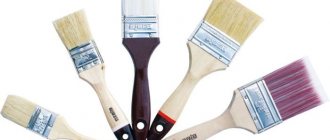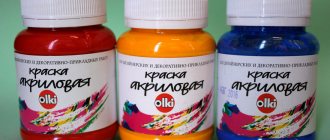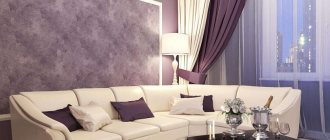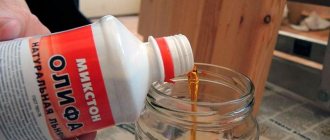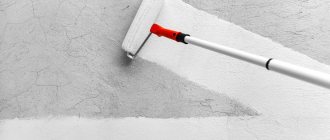Paint for bricks can be anything: acrylic, latex, oil, silicate. It is applied to the wall differently than conventional paint and varnish and is used not only for additional protection, but also for decorating brick walls.
Before you begin the exterior finishing of the facade, you need to familiarize yourself with the basic requirements for using paint and varnish solutions.
What kind of paint should be used for bricks, and how to apply it correctly to brickwork?
What you need to know before painting a brick building
The application of paints and varnishes to brick walls is not initially intended, because the brick itself is very strong, does not deteriorate and retains its original appearance for many years.
But there are cases when the façade needs to be updated:
- Mold, moss or dirt on the surface of the brickwork.
- Salt deposits (a white coating forms if clay with a high salt content was added to the composition during construction).
- The building is more than 5 years old and is built of low-quality brick.
Craftsmen do not advise painting brick immediately after building a house; it is advisable to wait at least 12 months.
If you don’t have time, you can paint the facade a month or two after construction, but before that, a primer for the brick must be done.
It is advisable to treat the walls with a primer containing alkali.
If the brick begins to become moldy or blackened, it’s time for an update (usually more than 5 years have passed by this point).
The masonry must “settle”, dry and harden. If you painted a wall immediately after building a building, there is a high chance that mold or mildew will appear on the surface of the walls over time.
Painting bricks is often used not only as a protective agent, but also as a method of decoration: patterns, ornaments, even portraits are painted on chimneys.
By painting the walls, you can not only improve the appearance of the building, but also stop putrefactive processes. If the brick is not treated with anything, it will begin to crumble, turn green or become wet.
Important! Decide exactly on the color of the facade: if suddenly, after painting the building, you don’t like the shade, then it will be very difficult to remove the layer, and even more difficult to repaint it differently.
How to Paint a Brick House Outside - Types of Paint, Instructions, Mason Tips
Creating beauty inside and outside your home is the natural desire of every home owner. Painting a brick house protects against adverse weather conditions and at the same time creates an attractive appearance. The availability of paint on a brick facade provides an opportunity to update the appearance of a building without excessive costs. It is worth taking a responsible approach to the choice of paint and varnish coating, then the neat appearance of the external walls will remain for 5 years. This effect is achieved only by maintaining the paint application technology, not forgetting about the necessary preparation.
It is not recommended to paint fresh brickwork, since drying, weathering of the material and leaching are completed only after 6 months.
General requirements for paint for external work
The outer walls of a building often deteriorate due to rain (especially if there are no drainage systems, no canopy or leaky frames), ultraviolet radiation, and steam escape (insulation problems). Poor exterior finishing “wets” the brick, causing it to begin to collapse.
Before buying paint, you need to find out the reason for the destruction of the walls.
You need to adhere to some rules - not every paint is suitable for chimneys.
The choice of paint largely depends on environmental conditions.
To restore and protect a brick wall, you can choose a moisture-resistant paint and an additional water repellent - a solution with organosilicon compounds that is added to water or a solvent (also suitable for concrete).
The solution will prevent moisture from being absorbed into the brick.
Note: one of the main reasons for the destruction of brick is its poor quality.
How to choose the right paint for exterior decoration: basic criteria
If the external walls are covered with salt deposits, then choose facade paint for external work on bricks that is as resistant to alkalis as possible (latex paint forms a protective film through which salt cannot penetrate).
White coating on surfaces cannot always be seen - in some cases it can be completely transparent. A pronounced coating of salt is called efflorescence - the more alkali there is, the more it is released on the surface of the walls.
There is always alkali, but in different percentages.
Ultraviolet radiation and weather conditions
Over time, under the influence of sunlight, the wall begins to fade. On one side the brick can be a dark shade, and on the other it can be light. To avoid such differences, use paint that protects the coating from fading.
Brick paint for exterior use must be resistant to temperature changes and not allow moisture and snow to penetrate into the seams between the bricks.
Paint and varnish compositions must have good vapor permeability - this means that after drying, the paint must allow air to pass through (especially for rooms where interior decoration was carried out).
It is important that the wall “breathes”, then the masonry will be more stable.
Do not forget about the description of the characteristics on the can - along with the listing of the composition, the paint consumption per 1 m2 is indicated on the tube.
The less specified, the more economically the material will be used. Each jar indicates a different value. In the description you can find out the time when you need to update the facade.
An important factor when choosing paint is high susceptibility to mechanical damage.
Paint is especially sensitive to abrasive dust - powder obtained as a result of grinding or polishing surfaces. The material that is “ground” loses particles, dissipates, which means the paint may peel off.
The color of paint for bricks for exterior use can be any, the main thing is to choose waterproof compositions with protection against fading.
As for indoor walls, ultraviolet radiation does not have such a strong effect on indoor walls.
Do not forget about adhesion - the better the adhesion of the surfaces of dissimilar solid or liquid bodies in the paint, the longer the service life of the brick (good adhesion should be not only with the brick, but also with the cement mortar).
If adhesion is at the highest level, then the solution can be applied to the walls without prior priming, and this is a plus.
When the wall surface is heated, the paint must be plastic and compensate for the thermal expansion of the walls.
Another important quality is ease of application and speed of drying (it is not recommended to use quick-drying paint).
The shelf life of paint materials depends on the composition and its manufacturer. The maximum period is no more than 9-10 years.
After this period of time, the external façade will have to be renewed again.
What to look for when buying paint and varnish products
In order for the fence to please you with its presentable appearance for a long time, and for the balcony and outside walls of your home to not crack, requiring repeated repairs, you need to choose the right coating
When choosing how to paint a brick with your own hands, it is important to take into account: Exterior brick paint
Exterior brick paint
Economy. Consumption for different types of surfaces (brick, gypsum, ceramic tiles) and depending on the properties of paint and varnish compositions will vary. Convenience. The high-quality mixture fits well on walls or tiles and is easy to use. Fast drying
This quality is important when carrying out external work, when precipitation can spoil wet paintwork. For interior decoration inside buildings, this quality does not play a big role. To maintain a decorative appearance for a long time, the paint must be easy to clean.
Painted surfaces should be easy to clean from dirt and wash with water. To impart such qualities, some dyes can be varnished. Tinting option. Is it possible to add an additional shade to the paint mixture using color additions? Some formulations do not allow this possibility. Light fastness, resistance to UV rays. This quality especially needs to be taken into account when carrying out work outside (painting a balcony, facade or fence). The use of dyes with poor light fastness can lead to buildings quickly losing their beautiful appearance. When working on interior design, light resistance is selected taking into account the shading of the premises. Heat resistance. For exterior work it is necessary to use frost-resistant paints; to decorate stoves and fireplaces in the interior of a house, heat-resistant dyes are needed. Heat-resistant paints should be used for stoves and fireplace pipes. Resistance to external influences. Painting compositions must reliably protect walls, balconies or fences from damage and environmental influences. Reflective properties (matte or glossy). Matte is well suited for gypsum tiles or well-leveled brick walls. A fence or balcony of a house painted with such a building mixture will not look aesthetically pleasing, and unevenness will become visible. Such defects can be easily hidden using glossy dyes.
Requirements for paints for interior work
Water-based compositions for indoor use are the safest and do not contain harmful chemical compounds - usually the emulsion contains water with polymers, mineral or acrylic resins. The paint is odorless, dries quickly and easily changes shade when adding other colors.
Creating a Volume
This is the most important stage. It helps make the wall look natural. The volume creation method is suitable for all of the above methods.
- To make the painted bricks look realistic and three-dimensional, you need to add additional shades. To do this, lighten the upper edges and slightly darken the lower ones.
- To give it a “careless” look, use a sponge. With its help, strokes and strokes are applied to the surface. This “aging” the brick.
- To make the image of masonry joints look deeper, you can take a thin brush and outline the outlines of the joints with a darker shade.
- When applying lines and strokes, random spots and small stains may appear. They must be removed immediately, before the paint has time to dry. You can wipe it off with plain water.
It’s not difficult to bring an interesting design solution to life by painting the walls to look like brick. It is important to be careful and follow the sequence of actions. When starting finishing, it is necessary to take into account that subsequently the coating should be renewed every few years.
Overview of paints for brickwork
What colors are there:
- Acrylic – suitable for concrete, brick, wood. Warranty up to 20 years.
- Water-dispersed on a mineral basis - suitable for brick, slate, metal, brick. Warranty up to 10 years.
- Water-dispersed on an organic basis - for brick, slate, glass, plastic, wood. Warranty up to 20 years.
- Oil – with drying oil for wood and metal structures. Warranty up to 3 years.
- Silicate with liquid glow glass - suitable for all surfaces. Warranty up to 20 years.
- Silicone with resin - for all surfaces, 20 year guarantee.
- Polyvinyl acetate – slightly matte, for interior use only.
- Enamel with alkyd resins is only suitable for wood. Warranty up to 10 years.
In some cases, paints and varnishes with the addition of PVA glue are used, but they do not protect well from moisture.
For exterior decoration, vapor permeability is of great importance - feel free to choose latex or acrylic paint.
Before buying paint, do not forget to read the characteristics - there are compositions intended for new, newly built masonry, and there are only for old ones that require deep restoration. Each paint and varnish material differs in composition.
Some manufacturers indicate exactly what the composition is intended for - for painting walls, floors or a fireplace.
Popular paint brands
Review
Mineral-based water emulsion is considered the cheapest (contains lime and cement), the most expensive paint is silicone: suitable for rooms with high humidity.
One of the most affordable and high-quality paints is acrylic on a water-dispersion basis and is highly resistant to alkalis ().
Paint “Sicily” with silicone additives, elastic and UV resistant. In addition, the composition protects from moisture, prevents moss and mold from growing, and washes well.
“Mineral Strong” – is characterized by increased resistance to linear changes in the surface.
“Winterol” is a water-borne acrylate paint that allows air to pass through and protects the surface from mold growth and exposure to ultraviolet rays (does not fade). The composition contains a binder plyolite - a thermoplastic resin.
Which brick paint is best for exterior use?
One of the highest quality compositions includes “Siloxane” - a solution based on a silicone binder (polyorganosiloxane) with a matte finish.
Ideal for exterior façade work: it repels water thanks to a protective film that prevents efflorescence from forming on the surface.
“ELCON” is heat-resistant, suitable for painting fireplaces and stoves, and can withstand maximum temperatures (up to 600°C).
“WERES” – creates the effect of a wet stone, removes white deposits. Consumption 1 kg up to 6m2.
Brick is very porous and needs additional protection, so it is important that the paint has good coverage and elasticity.
It is better to buy more expensive paint than to pay twice as much for repainting.
Types of paint and varnish coatings
Let's look at the main types of wear-resistant brick paints intended for outdoor use.
Acrylic
Such compositions are characterized by good resistance to temperature changes and can be used for eight to eleven years. Walls painted with acrylic paint do not develop cracks and respond normally to wet cleaning. The covering layer does not crumble from exposure to sunlight and precipitation. The main component of the composition is a resin that does not absorb water well.
It is believed that newly erected brick walls should not be painted immediately, but this restriction does not apply to alkyd compositions. They contain a binder component that counteracts the alkali corrosion characteristic of fresh masonry mortar. So if a month has passed since the construction work, you can safely paint the walls with acrylic composition.
Silicone
Paints in this group have good durability and dry within three hours after application. The siloxane composition present in the material reliably protects the surface from the formation of fungal mold. When exposed to ultraviolet light, the paint does not change its original shade.
Silicate
Dust and dirt are removed naturally from a brick surface painted with this composition when precipitation occurs. A house painted with silicate paint will last for twenty years without requiring repairs. The main color of silicate group paints is considered to be white, but by adding dyes it can be converted to another shade.
The material is applied in two layers, with an interval of one day.
Enamel
The material is toxic and flammable and contains varnish. It has good water resistance, strength and corrosion resistance. Final drying occurs after six to twenty hours.
Water soluble
Durable paint used for painting wall facades. This material can be used to paint brick chimneys and perform interior decoration. Water-soluble paint is an excellent choice for facing, gypsum or sand-lime bricks. It is characterized by sufficient vapor permeability, guarantees complete exchange of moisture and gas between the wall and the atmosphere, does not contain toxic additives, and is not flammable.
Mineral
Such paints are made on the basis of cement material, are excellent for finishing facades, have good resistance to moisture and temperature changes, and create a reliable protective layer for brick walls. The operational period is ten years or more.
Epoxy
They differ in different qualities; due to the resins they contain, they are toxic and environmentally friendly. They adhere well to the brick surface, but do not withstand the effects of natural factors well. To extend the life of such paint, a varnish layer is applied on top of it.
What tools will you need for the job?
- Sandpaper with different grits or a sanding machine if the area is large.
- Respirator and gloves.
- Metal scraper.
- Pallet.
- Spray gun.
- Glasses with direct ventilation.
- Roller (medium bristles) or brush with long bristles. Optimal width up to 100 mm.
It is not so easy to remove oil-based paint with a scraper, but water-based paint “comes off” easily.
The spray gun can be manual, electric or pneumatic, very convenient to use and suitable for painting walls and ceilings.
Only water-based paint can be added to a hand-held spray gun.
Nuances of facade painting
You can paint the walls 1 - 2 years after construction, so that shrinkage occurs.
In order for the paint on a brick facade to last a long time, you need to follow the following recommendations:
- Walls should not be painted earlier than a year after construction. The walls and foundation will shrink to some extent; the stone must reach an acceptable level of moisture.
- Be sure to treat the walls with antiseptic solutions, otherwise the appearance of mold cannot be avoided.
- As additional equipment, you will need walkways or trestles, since painting walls from a stool or ladder is inconvenient and dangerous.
- When painting walls, especially with organosilicon compounds, you need to wear protective clothing. An apron, mittens, a protective mask, and sometimes a respirator are required.
- A layer of paint is applied to the entire surface at one time. If the area is large, you can take a break for a couple of hours, but no more. Otherwise, the shade will differ in different areas.
- Be sure to apply 2 layers of paint. It is not possible to achieve uniform coating in one time.
Painting a brick building is done to protect the walls from moisture, salt air, snow or to make the facade decorative. The work is simple and can be done on your own.
Preparing brick walls for painting
Clean cracks and chips (you can go over the surface with a wire brush). Cover deep potholes with cement; small ones can be painted over with paint (preferably latex).
If you don’t want to spend money on expensive products, you can prepare a solution for mold and mildew yourself: dilute water and white in different proportions, apply to the walls. Leave the solution for half an hour, then remove the mold with a brush and rinse the surface with water.
It is worth considering that home remedies are not always effective, and mold may reappear over time.
Sometimes greasy stains appear on the walls - if they are not removed, then no paint will be able to stick to the surface.
The cardinal method for removing grease stains from brickwork is to replace the bricks with new ones.
Washing with water and vinegar: how to remove greasy stains on walls
The easiest method for removing light dirt and grease stains is to wash the surface with soap and water (you should start moving the brush or sponge from the top corner, gradually moving down). Choose a brush with natural or artificial bristles.
Wet the dirty area with soapy water and leave for 5-10 minutes.
At this time, prepare a vinegar solution: dilute water and vinegar essence in 1:1 proportions.
Rinse off the soap solution and treat the wall with vinegar.
If the grease stains are persistent and old, simple methods will not help, you need to use chemical solutions.
Types of degreasing impregnations
Degreasers are good for removing greasy stains or drying oil.
The product is a universal impregnation that removes not only stains, but also efflorescence and does not allow moisture to pass through.
There are spray stain removers that remove grease and oil from terracotta tiles, natural stone, granite, cobblestones, marble, brick, clinker:
- “FILANOSPOT” is enough to spray onto the area of contamination and wait 5-10 minutes.
- The FILAPS87 product not only degreases, but also removes wax (the best product for removing stains from porcelain stoneware).
Using a brush or special solutions, clean the walls from mold, dirt or mildew.
Pre-cleaning solutions:
- The waterproofing agent “Fongifluid” is ideal for cleaning external walls of facades; it leaves no marks after application, does not change color, and removes mold, mildew, moss, lichens and other microorganisms.
- Polyfluid" is a transparent moisture-proofing solution with synthetic resins, it is a deep-penetrating waterproofing solution that helps dry damp walls and eliminate the cause of moisture accumulation.
After applying “Fongifluid”, leave it for at least 5 days, then clean the walls with a brush and wash with soapy water (if there are no defects).
“Polyfluid” is not considered a full-fledged sealant, although it retains moisture, it cannot contain high water pressure. The solution is absorbed into the pores of the brick and, when moisture penetrates, it releases crystals that prevent water from penetrating inside.
“Polyfluid” contains white spirit.
Sometimes the entire wall is primed with cement mortar - this way you can not only protect the surface from moisture, but also achieve greater adhesion to the material, which means the paint will last longer and its consumption will be reduced.
If you decide to pre-prime the facade, choose a primer mixture with the addition of latex or acrylic solution. Apply at least 3 layers to the surface with a thickness of no more than 2 mm.
Before applying each layer, you need to wait until the previous one has dried (at least 3 hours).
After applying and drying the primer, remove dirt and excess particles using sandpaper.
If the brick was once painted, remove the old paint layer with solvent.
Another way to clean surfaces is water jet cleaning of walls with dust-free water.
You can clean painted walls using soft blasting - equipment with special chemical but completely safe reagents; the solution cleans the surfaces of plaque, dirt, soot, rust and patterns without destroying the base.
How to remove white plaque from walls
Rinse off the efflorescence with water (can be diluted with vinegar), without using acidic solutions. Wait for the wall to dry: if white streaks remain, wash the surface again. White deposits in the form of crystals may appear after cleaning several times. You can't leave him.
Unfortunately, even after thorough cleaning, efflorescence remains. You can buy a special “Antisol” solution, which contains an acidic solvent (it is not recommended to buy it, even though it dissolves salt).
Do not start work if the brick is wet. If the wall does not dry completely, the paint will swell after application and fungus will form on the surface. To prevent this from happening, it is recommended to wait at least two weeks.
It is better to paint the brick facade of a house outside in the summer, when the temperature rises to 24°, otherwise the layers will lie unevenly and streaks will appear on the surface.
If you are planning to paint brick walls indoors, the time of year does not matter. Before applying paint, the surface must be washed with water and a diluted soap solution.
Do not leave crumbled bricks, fill them with cement. To prevent the seams from crumbling, apply cement into cracks and depressions in two passes.
Wait for the first layer to dry, then apply the second (you don’t need to wait for the first layer to dry completely, it will be more difficult to work).
The better you clean and seal the wall, the less paint will be wasted and there will be no cracks on the surface.
The next step is to apply the primer mixture to the surface, preferably in two layers. The liquid will help strengthen the adhesion of materials to the surface. If necessary, lubricate the seams with a brush. Wait for the soil to dry (at least 4 hours at a temperature of 20 ° C).
Step-by-step dyeing instructions
Before you start painting, you need to remove all furniture from the room. The floor can be covered with newspapers or oilcloth. If the wall is painted inside a building, then a roller and brushes are used for this. Work starts from the top corner.
The first coat of paint is thinned before application. This solution will serve as an additional primer.
Paint is applied in horizontal stripes. The strokes are made according to the masonry pattern. It is necessary to ensure that the overlap of the strips does not exceed 2 cm. It is more convenient to paint the central part of the wall with a roller, and it is better to paint hard-to-reach places, for example, the corners of the room, with a brush.
There are several ways to obtain the desired effect from coloring:
- Paint the entire room the same tone.
- Paint one wall one shade and the rest another.
- Apply paint of one color to each individual brick, and use a different color for the seams. For this work, only a brush is used.
- Use a sponge to apply paint unevenly. Due to this, you can achieve the effect of faded paint.
- Use stencils. To do this, stencils are applied to a pre-painted wall, the slots in which are painted with a sponge.
An example of painting a wall one color is shown in the video. This option is suitable for almost any interior.
https://youtube.com/watch?v=iu5jQnbw5Nc
If the wall of the facade of a building is painted, then the technology is similar to interior painting. To simplify the work, when painting a wall outdoors, you can use a spray bottle.
Wall preparation: measurements, paint consumption
The area of walls without window and door openings is easy to calculate: multiply the length of the wall by its height. The area of the wall where the door is located is minus (the area of the wall minus the area of the door). The window area is also minus.
Paint consumption per 1m2:
- Oil – about 150 g per 1 m2.
- On a water-based basis - up to 300 per 1m2 (at least 2 layers are required).
- Acrylic – 150 g per 1 m2. Often requires the addition of film-forming substances (drying oil).
There are special water-based compositions that promise that 1 liter of paint will be enough for 18 m2, and only one layer will be required. But you shouldn’t trust such bold assurances.
After you take measurements, decide on the color and amount of paint - take a little more than calculated (about 10%). Despite these characteristics, paint may be spent more than planned - there may be microcracks on the walls.
Important points
In order for the paint to lay evenly on the wall and last a long time, you need to take care of priming the wall. Despite the fact that manufacturers claim that paintwork can be applied to bricks without any problems, dust residues that are inevitably found on the wall can cause the paint to peel off. The primer will get rid of dust and strengthen the brick, and most importantly, the mortar, which most often begins to crumble over time.
The second important nuance that will need to be taken into account when painting a brick wall is the seams. You can paint the wall along with the seams - in this case, painting is done without pre-treatment of the seams. And if you want to leave the seams for better aesthetics, then you will have to cover the solution with strips of masking tape; alternatively, you can use a paint roller with a small pile or made of foam rubber for painting. In this case, the paintwork will not get on the seams, especially if you carefully paint each brick with a small roller.
Technology for painting brick surfaces
To avoid washing paint off windows, doorways or furniture, cover them with film or cardboard (especially if you decide to use a spray gun).
If you paint with a brush instead of a spray gun, then choose a width of no more than 100 mm, then the paint will apply evenly and without streaks.
Typically, a brush is used indoors, and a wide roller or spray gun is used for exterior finishing (the area is too large). It is better to choose a soft roller; it will paint better and will not leave empty areas.
Sometimes wall surfaces are painted with a sponge, but the result can be disappointing - the masonry will seem old or faded (if you yourself did not want such an effect). Using a sponge, you can apply decorative highlights on top of the main layer - you can make a light coating of gold or silver dust, or draw a design using a stencil.
You can apply paint from any corner of the house.
Details should be taken into account: for a brush, the paint does not need to be diluted, it should be slightly thick, and for a spray gun, on the contrary, it should be liquid (a solvent is added if necessary).
It is recommended to paint a brick wall in a room with compounds that allow air to pass through and allow the masonry to “breathe.”
Spray painting of brick facade walls
For quality work, you need to choose spray guns at a good price. A cheap tool can only spoil the surface or not give the expected result - the stream will splash in different directions or give insufficient pressure. Paint consumption will increase greatly.
After dilution, the solution is poured into the spray gun through a strainer.
How to paint a brick wall with a spray gun: the jet from the spray gun should be directed only from bottom to top; you also cannot stop during the painting process. If there is a blank spot left, go back and paint it.
If you paint according to all the rules, you can reduce paint consumption by 5-10%.
Painting a brick facade with a roller and brush
The wide roller is very convenient; painting with it is easy and quick. But the main disadvantage of the tool is that the seams on the masonry may remain unpainted. You have to go back to the missed places and paint over the spots with a brush. During the painting process, particles from cement and sand stick to the roller or brush between the seams of the brickwork.
You can paint surfaces with a sponge, but only in rooms (the effect of a shabby retro wall is created).
Test of budget facade paints video
Technology and choice of paint for interior wall painting
The main thing when choosing paints and varnishes is non-toxicity and the absence of harmful chemical impurities in the composition.
When decorating the interior of rooms, do not forget to cover the furniture and flooring with newspapers or polyethylene.
To apply the mortar, a brush or roller is often chosen, while the brick is painted with one color and the seams with another. If you wish, you can paint each brick in your own color or create an original design (the work will require a lot of time and effort).
The brush fits better in your hand, you can feel every groove and paint the surface thoroughly. Unlike working with a spray gun, brush movements should be made in a horizontal direction.
Which brush is needed for which paint:
- Acrylic – high quality bristles made of polyester fiber are suitable.
- Alkyd or oil brush with natural hair.
To paint corners, choose a narrow brush that must have a cut edge.
If you are using a roller, be careful not to move the handle too quickly along the wall, as this may cause you to miss an area or splatter the solution. The roller is suitable for creating a primer, corrugated layer.
Do not hurry. After applying the first coat, wait until it is partially dry and only then apply a second coat of paint (gently touch the wall with your fingers - it should be slightly tacky, half dry).
Requirements for paint for stoves and fireplaces
A fireplace in the house creates comfort and an unusual atmosphere. The material for construction can be anything, but the simplest option is brickwork, which begins to deteriorate over time, just like any other material.
Painted brick can crumble, dry out or crack when exposed to high temperatures (sometimes reaching 80°C).
To prevent this from happening, the paint must be heat-resistant, and its color must be as dark as possible - dark shades give off heat more than light shades. Light shades, although pleasant in appearance, have much worse heat transfer.
Do not buy aluminum paint or its analogues, which are more suitable for painting metal parts. Also, you should not use oil compositions with drying oil - over time, the shade on the surface may become dark (due to high temperature).
How to paint a fireplace or stove, the best compositions:
- Organosilicon base in paint: this composition strengthens the base of the masonry and prevents the material from collapsing.
- It is better to paint with pentaphthalic enamel or nitro paint (enamel based on cellulose nitrate).
Heat-resistant paints include:
- Heat-resistant paint for stoves and fireplaces from.
The fireplace can be painted with heat-resistant varnish, ordinary chalk, lime, or you can prepare the composition yourself.
Heat-resistant varnish enhances the strength of brickwork.
If a wall covered with lime is whitewashed with chalk, the composition will quickly fall off. All materials must be the same and have high adhesiveness.
The more resins in the composition, the longer the color will dry.
How to paint a fireplace correctly
Currently, rustic style is gaining popularity in interior design. Decorating a house in a country style fills the room with comfort and brings you closer to nature. Previously, fireplaces and stoves were painted with lime; now they have begun to use water-based compositions that retain their original appearance and are more durable (lime wears off after just a year).
To prevent brick paint from peeling due to temperature changes in the oven (heating up to 80-100 °C), choose only fire-resistant paint materials.
As for the fireplace, it doesn't get that hot.
Otherwise, painting a fireplace is no different from painting an ordinary brick wall.
When is it necessary to paint?
Facade paint for bricks is used in the following cases:
- if the walls are covered with efflorescence - a white salt coating that destroys the brick. Efflorescence is not washed off, and before applying paint, such areas are treated with a special acid composition;
- the masonry has lost its original aesthetics, has faded, and is covered with unattractive abrasions;
- minor damage appeared. In this case, before applying paint, the problem areas are finished with a plaster mixture;
- there was a desire to simply change the decor of the building.
Painting a brick wall with façade paint has a strengthening effect on the crumbling base and gives it a decent appearance.
How to care for walls after painting
Periodically you need to check the brick wall for mold or mildew. Wash off light stains with soapy water. Carefully remove mold or mildew with a scraper, cover the damaged areas, wipe with sandpaper and paint over it if necessary.
At first glance, painting brick walls seems like hard work, but if you think about it, the most difficult thing is to follow strictly according to the scheme, where the most important thing is to clean and prepare the brickwork for work.
Repair of crumbled bricks. Video
How to paint brick?
Painting sand-lime brick is not a complicated process. To cover a wall with paint, use standard tools: roller, brush, sprayer. In order for the mixture to adhere well, the surface should be pre-prepared:
- The surface must be dry. You need to make sure that the brick is not wet.
- Apply only to a base that has been cleared of old dye. Previously painted bricks must be thoroughly cleaned and washed. Wipe off dust, mold, excess solution, dirt.
- Be sure to clean off the white deposits - these are salts washed out of the brick by moisture. Before painting a brick wall, you should clean it thoroughly with a brush and/or water.
- It is advisable to use a primed surface. This technique will be more expensive, but the quality of applying the mixture to the wall will be significantly higher.
Why do you need tinting?
Kohler is a paint of a very bright and saturated color, which is used to give the desired shade to various paints used in construction. This is achieved by mixing the color with white paint. Before doing this, you need to dilute it with a small amount of water and stir until smooth. The shade depends on the amount of color. It is usually mixed with water-based paint.
Advantages of the color:
- low cost;
- wide choice of colors;
- environmental friendliness;
- relative ease of use;
- practicality;
- the ability to independently obtain the desired shade of paint;
- long service life;
- color stability.
How to choose the right paint?
Painting brick is a responsible matter, and the choice of paint should be no less scrupulous. Coatings for stone and brick facades are selected according to several criteria:
Binders
The main types of paints according to their composition have already been described above; this classification should be used as a starting point when choosing a material based on its binder. However, sometimes other binders in the composition, such as cement or lime, are indicated on the packaging. But the composition of the binder is not as important as its quantity.
Water permeability
Since painting brick is not only an aesthetic matter, but also a preventive measure against premature destruction, the level of water permeability of a certain type of material must be high. Of course, more often than not, many consumers are attracted by the low price, and they do not pay attention to the quality of the material. Price matters! High water permeability will contribute to the appearance of cracks, peeling and salt deposits on the wall. In addition, the development of fungus and mold is inevitable, which not only spoils the structure of a brick or stone house, but also affects the health of others.
Resistance to sunlight
Painting a brick wall performs one of the functions of protecting the facade from exposure to solar radiation. Excessive solar radiation causes paint to fade, cracks and blisters to appear.
Ability to pass steam
Allows excess moisture from evaporation to be removed outside. Facade paints for bricks, as mentioned above, also have protective functions. One of them is to prevent the formation of mold and mildew not only outside the house, but also from the inside. When the material allows excess moisture to escape, there will be nothing for mold and mildew to form on.
Wear resistance
The paint is subjected to the greatest abrasion during washing of the facade and in places where a person comes into contact with it the greatest number of times (for example, near doorways). The paint packaging usually indicates the number of dry and wet washes that it will withstand before it is completely abraded.
Flow level
There are facade paints for bricks, the price of which is quite low, and the quality meets all needs. However, not everything is so smooth: before choosing a jar that comes into your hands, you should first carefully study its consumption per 1 m².
Time it takes for the paint to dry completely
Painting a house is usually done in 2 stages, 2 layers. On packaging with façade paint, 2 time parameters are usually indicated. The first time indicates how long you should wait after applying the bottom coat before applying the second, and the next number indicates how long it takes for both layers to dry completely.
Comparison of facade paint with the addition of silicone with facade paint without its addition.
Preparatory stage
Even the highest quality coating will not last even a year if the surface is not properly treated. Preparing walls for painting proceeds as follows:
- The surface must be thoroughly cleaned not only from dirt, but also from broken fragments of masonry; Sometimes you have to use a scraper or a stiff wire brush to do this.
- Wash the wall with soap, paying special attention to efflorescence (salt stains) and oil stains.
- The surface will dry within a week. Brick is a very porous material that quickly absorbs large amounts of moisture.
- If the wall needs restoration, then all cracks and potholes must be puttied and sanded after complete drying, and cleaned of dust.
- Now you can apply a layer of sealant or varnish to enhance the protective properties and durability of the coating.
- A brick wall must be primed before painting. The primer will protect the surface from harmful bacteria and fungi and ensure good adhesion to the paint. The composition must be applied at least twice after the necessary period of time for drying.
How is the facade painted?
Important! If a brick house has just been built, you need to wait at least 1 year before painting its facade. This is due to shrinkage that occurs during the annual cycle under the influence of different weather conditions.
Before you start working with paint, you need to cover all the cracks and holes in the wall with cement mortar; small cracks are sealed with plaster. Then you should carry out the so-called cleaning of the facade from contamination, especially if the house is not a new building, but has been serving its owners for many years. The walls are cleaned of numerous layers of dust and soot, and if necessary, then of old paint. Cleaning is done using the “rough” method using a hard spatula or iron brush. In this way, cement cones and salt build-ups are removed from the wall. After the rough cleaning is complete, all walls of the house should be rinsed with clean water from a hose. The remaining dust and dirt are finally swept off the walls with a regular brush.
Walls that are wet after watering with a hose are treated with a special facade cleaner and after 5 minutes the full cleaning cycle is repeated. After which you need to prime the entire facade, which will be painted.
Also, when preparing a brick wall for painting, a number of mandatory works are performed to remove excess moisture and eliminate leaks. Moss, if any, is removed from the walls, and the wetted surface must be treated with herbicide, after which it is washed. If there is mold, the walls are treated with a solution of bleach and water.
This completes the preparatory stage and the actual painting of the facade begins.
Experts and those who have at least once encountered painting the facade of a house say that the best tool in this matter is a regular paint brush. Painting the facade with a brush allows you to paint over all the seams.
To prevent facade paint from getting where it shouldn’t (for example, on a window frame), jambs in doorways and other elements should be taped with tape or masking tape before painting. When painting, it is recommended to lay film, fabric or old newspapers on the floor. This will protect the floor from dripping paint.
The wall is painted in 2 layers. After applying the first layer, wait the time indicated on the paint packaging.
Painting the facade of a brick house should be done in dry, warm and not too sunny weather. It is advisable to calculate the time so that the weather favorable for work does not change for the next 2-3 days.
Peculiarities
Today, a number of materials for exterior finishing work are available on sale.
Modern paint and varnish products have a number of the following properties:
- complete absence of chemically harmful substances in the composition;
- resistance to mechanical stress and sunlight);
- elasticity of the coating after painting;
- high moisture resistance;
- compatibility with other paints;
- wear resistance;
- very easy to clean from dirt;
- vapor permeability.
Sand-lime brick paint is suitable for painting both a new house and old buildings. It is easy to apply, does not form streaks, and does not splash. It is much cheaper in cost than other materials and is more accessible to a wide range of consumers.
In general, brick, according to its characteristics, is a material that is completely ready for long-term use while maintaining its original appearance. However, the building will look familiar and of the same type. The colors will give it a completely new, sometimes fabulous appearance.
The main types of paint and varnish coatings for bricks are acrylic, silicone, silicate, and enamel paints. They come in glossy, semi-matte and matte. Each has its own reflective ability (complete absence in matte, greatest in glossy).
Acrylic coatings are highly resistant to temperature changes; their service life is 8-11 years. Facade painted walls are not subject to cracks and are easy to clean. The paint does not crumble under the influence of rain and sun. Acrylic resin is added as a component, so moisture is poorly absorbed.
In most cases, it is not recommended to apply coatings to a newly constructed façade. This rule does not apply to acrylic paints, since they contain a binder material that stops the alkali corrosion present in the fresh solution. Therefore, within 30 days after the construction of the building, it can be painted in any color.
Silicone paints and varnishes are durable and dry quickly (- 3 hours after painting). The siloxane (resin-based) solution contained in their composition protects against mold and mildew. In regions with hot climates and high air temperatures, painted facades do not change their appearance when exposed to ultraviolet rays.
Contaminants in the form of dust on covered buildings are very quickly removed naturally (by precipitation). A painted house can last 18-20 years before the next renovation. Various tinting agents are used to change the color of the paint. The main color is white. You can convert it to any.
Silicate paints are susceptible to changes in air temperature. They tolerate moisture well, have high vapor permeability and fire resistance. Apply in two steps. The first layer dries in 24 hours. The second one is in 8-11 hours.
Enamel coatings are fire hazardous and toxic. They contain varnish. However, these paints are very moisture resistant, durable and corrosion resistant. Drying period – 6-20 hours.
A special mineral paint for bricks has been created based on cement. It is intended for previously painted facades that are difficult to restore. The degree of water resistance and vapor permeability of this paint and varnish material is very high. The color of a brick house will not change for 10 years after treating the walls with this paint.
Oil paints are used much less frequently. Most often they are used to paint Russian stoves installed in summer kitchens (temporary buildings). It is very convenient to apply beautiful artistic ornaments and designs using this paint and varnish material.
The best option for painting are multi-colored latex acrylic paints (Belinka, Sicily, Acrylatil, Husky, Mikrel and others). Each of them has its own unique characteristics.
Sicily paint is a silicone-modified, alkali-resistant, self-cleaning material. Used for facades of houses located in dusty areas.
Which one to choose for painting a brick facade?
External walls are often finished with facing bricks. This brick does not require additional coating
. But there are cases when it is necessary to paint sand-lime brickwork.
For example, you want to update an old wall or emphasize a masonry element. Sand-lime brick consists of quartz sand and lime, so you need to choose a coloring composition with high resistance to alkali. The properties are similar to ceramic, i.e. clay, but less water resistant
Therefore, when choosing a paint composition, the main attention should be paid to moisture resistance.
Most often, acrylic paints are used for these purposes, which, in addition to high moisture resistance, have good vapor permeability, wear resistance and an affordable price. Sand-lime brick has a light surface, so it is possible to use almost any color in painting
. Just remember that when repairing a painted surface, it is often impossible to change the color of the coating, because the darker color will show through the lighter paint.
